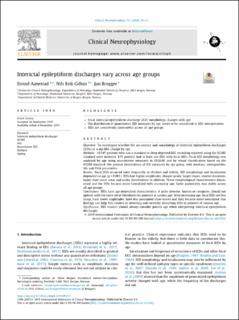| dc.contributor.author | Aanestad, Eivind | |
| dc.contributor.author | Gilhus, Nils Erik | |
| dc.contributor.author | Brøgger, Jan | |
| dc.date.accessioned | 2021-03-30T10:51:32Z | |
| dc.date.available | 2021-03-30T10:51:32Z | |
| dc.date.created | 2020-08-13T12:32:08Z | |
| dc.date.issued | 2020-01 | |
| dc.Published | Clinical Neurophysiology. 2020, 131 (1), 25-33. | |
| dc.identifier.issn | 1388-2457 | |
| dc.identifier.uri | https://hdl.handle.net/11250/2736112 | |
| dc.description.abstract | Objective: To investigate whether the occurrence and morphology of interictal epileptiform discharges (IEDs) in scalp-EEG change by age.
Methods: 10,547 patients who had a standard or sleep deprived EEG recording reported using the SCORE standard were included. 875 patients had at least one EEG with focal IEDs. Focal IED morphology was analyzed by age using quantitative measures in EEGLAB and by visual classification based on the SCORE standard. We present distributions of IED measures by age group, with medians, interquartiles, 5th and 95th percentiles.
Results: Focal IEDs occurred most frequently in children and elderly. IED morphology and localization depended on age (p < 0.001). IEDs had higher amplitudes, sharper peaks, larger slopes, shorter durations, larger slow-wave areas and wider distributions in children. These morphological characteristics diminished and the IEDs became more lateralized with increasing age. Spike asymmetry was stable across all age groups.
Conclusions: IEDs have age-dependent characteristics. A spike detector, human or computer, should not operate with the same set of thresholds for patients at various age. With increasing age, focal IEDs are less sharp, have lower amplitudes, have less prominent slow-waves and they become more lateralized. Our findings can help EEG readers in detecting and correctly describing IEDs in patients of various age.
Significance: EEG readers should always consider patient age when interpreting interictal epileptiform discharges. | en_US |
| dc.language.iso | eng | en_US |
| dc.publisher | Elsevier | en_US |
| dc.rights | Navngivelse 4.0 Internasjonal | * |
| dc.rights.uri | http://creativecommons.org/licenses/by/4.0/deed.no | * |
| dc.title | Interictal epileptiform discharges vary across age groups | en_US |
| dc.type | Journal article | en_US |
| dc.type | Peer reviewed | en_US |
| dc.description.version | publishedVersion | en_US |
| dc.rights.holder | Copyright 2019 International Federation of Clinical Neurophysiology | en_US |
| cristin.ispublished | true | |
| cristin.fulltext | original | |
| cristin.qualitycode | 2 | |
| dc.identifier.doi | 10.1016/j.clinph.2019.09.017 | |
| dc.identifier.cristin | 1823156 | |
| dc.source.journal | Clinical Neurophysiology | en_US |
| dc.source.40 | 131 | |
| dc.source.14 | 1 | |
| dc.source.pagenumber | 25-33 | en_US |
| dc.identifier.citation | Clinical Neurophysiology. 2020, 131 (1), 25-33 | en_US |
| dc.source.volume | 131 | en_US |
| dc.source.issue | 1 | en_US |

